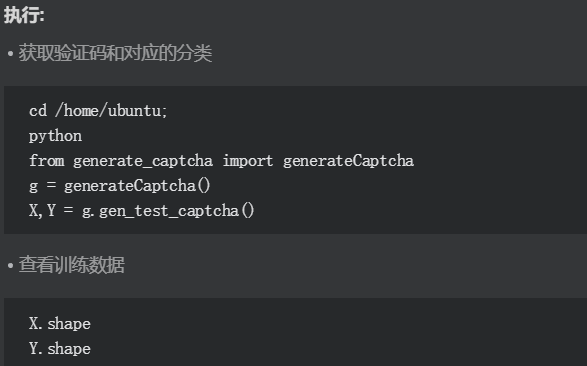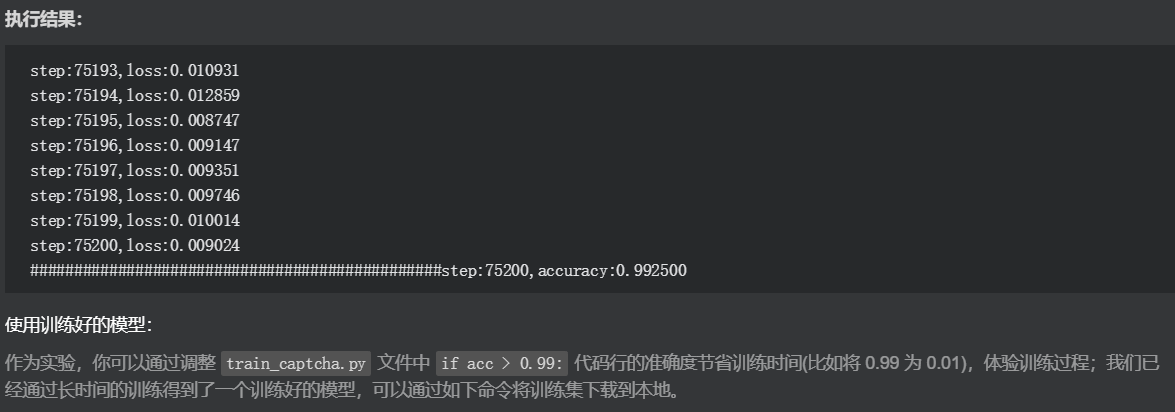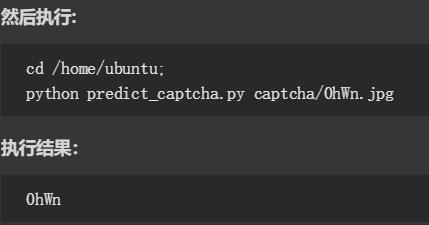课程地址:https://cloud.tencent.com/developer/labs/lab/10325/console
简介

数据学习
安装 captcha 库
pip install captcha
获取训练数据
本教程使用的验证码由数字、大写字母、小写字母组成,每个验证码包含 4 个字符,总共有 62^4 种组合,所以一共有 62^4 种不同的验证码。

#-*- coding:utf-8 -*- from captcha.image import ImageCaptcha from PIL import Image import numpy as np import random import string class generateCaptcha(): def __init__(self, width = 160,#验证码图片的宽 height = 60,#验证码图片的高 char_num = 4,#验证码字符个数 characters = string.digits + string.ascii_uppercase + string.ascii_lowercase):#验证码组成,数字+大写字母+小写字母 self.width = width self.height = height self.char_num = char_num self.characters = characters self.classes = len(characters) def gen_captcha(self,batch_size = 50): X = np.zeros([batch_size,self.height,self.width,1]) img = np.zeros((self.height,self.width),dtype=np.uint8) Y = np.zeros([batch_size,self.char_num,self.classes]) image = ImageCaptcha(width = self.width,height = self.height) while True: for i in range(batch_size): captcha_str = ''.join(random.sample(self.characters,self.char_num)) img = image.generate_image(captcha_str).convert('L') img = np.array(img.getdata()) X[i] = np.reshape(img,[self.height,self.width,1])/255.0 for j,ch in enumerate(captcha_str): Y[i,j,self.characters.find(ch)] = 1 Y = np.reshape(Y,(batch_size,self.char_num*self.classes)) yield X,Y def decode_captcha(self,y): y = np.reshape(y,(len(y),self.char_num,self.classes)) return ''.join(self.characters[x] for x in np.argmax(y,axis = 2)[0,:]) def get_parameter(self): return self.width,self.height,self.char_num,self.characters,self.classes def gen_test_captcha(self): image = ImageCaptcha(width = self.width,height = self.height) captcha_str = ''.join(random.sample(self.characters,self.char_num)) img = image.generate_image(captcha_str) img.save(captcha_str + '.jpg') X = np.zeros([1,self.height,self.width,1]) Y = np.zeros([1,self.char_num,self.classes]) img = img.convert('L') img = np.array(img.getdata()) X[0] = np.reshape(img,[self.height,self.width,1])/255.0 for j,ch in enumerate(captcha_str): Y[0,j,self.characters.find(ch)] = 1 Y = np.reshape(Y,(1,self.char_num*self.classes)) return X,Y
理解训练数据


generate_captcha_TEST.py

# -*- coding: utf-8 -* from captcha.image import ImageCaptcha import matplotlib.pyplot as plt import numpy as np import string import random class generate_captcha(): def __init__(self, width=160, height=60, char_num=4, characters=string.digits + string.ascii_uppercase + string.ascii_lowercase): self.width = width self.height = height self.char_num = char_num self.characters = characters self.classes = len(characters) def gen_captcha(self, batch_size=50): image = ImageCaptcha(width=self.width, height=self.height) X = np.zeros([batch_size, self.height, self.width, 1]) Y = np.zeros([batch_size, self.char_num, self.classes]) while True: for i in range(batch_size): captcha_str = ''.join(random.sample(self.characters, self.char_num)) img = image.generate_image(captcha_str).convert('L') img = np.array(img.getdata()) X[i] = np.reshape(img, (self.height, self.width, 1)) / 255.0 for j, ch in enumerate(captcha_str): Y[i, j, self.characters.find(ch)] = 1 Y = np.reshape(Y, (batch_size, self.char_num*self.classes)) yield X, Y def decode_captcha(self, y): # the type of y is np.array y = np.reshape(y, (len(y), self.char_num, self.classes)) return ''.join(self.characters[x] for x in np.argmax(y, axis=2)[0, :]) def get_parametets(self): return self.width, self.height, self.char_num, self.characters, self.classes def test_gen_captcha(self): image = ImageCaptcha(width=self.width, height=self.height) captcha_str = ''.join(random.sample(self.characters, self.char_num)) img = image.generate_image(captcha_str) img.save(captcha_str + '.jpg') X = np.zeros([1, self.height, self.width, 1]) Y = np.zeros([1, self.char_num, self.classes]) img = img.convert('L') img = np.array(img.getdata()) X[0] = np.reshape(img, (self.height, self.width, 1)) / 255.0 for j, char in enumerate(captcha_str): Y[0, j, self.characters.find(char)] = 1 #### test decode_captcha() decode = self.decode_captcha(Y) print("captcha_str: %s" % captcha_str) print("decode: %s" % decode) Y = np.reshape(Y, [1, self.char_num * self.classes]) return X, Y #### test test_gen_captcha() g = generate_captcha() X, Y = g.test_gen_captcha() # print(X) # print(Y) #### test gen_captcha() g_batch = generate_captcha() step = 1 while True: X, Y = next(g_batch.gen_captcha(5)) print(step, X.shape, Y.shape) step += 1 if step > 200: break
此文件是我练习时自己打的,加上了其中三个函数功能的测试
模型学习

1.CNN 模型

# -*- coding: utf-8 -* import tensorflow as tf import math class captchaModel(): def __init__(self, width = 160, height = 60, char_num = 4, classes = 62): self.width = width self.height = height self.char_num = char_num self.classes = classes def conv2d(self,x, W): return tf.nn.conv2d(x, W, strides=[1, 1, 1, 1], padding='SAME') def max_pool_2x2(self,x): return tf.nn.max_pool(x, ksize=[1, 2, 2, 1], strides=[1, 2, 2, 1], padding='SAME') def weight_variable(self,shape): initial = tf.truncated_normal(shape, stddev=0.1) return tf.Variable(initial) def bias_variable(self,shape): initial = tf.constant(0.1, shape=shape) return tf.Variable(initial) def create_model(self,x_images,keep_prob): #first layer w_conv1 = self.weight_variable([5, 5, 1, 32]) b_conv1 = self.bias_variable([32]) h_conv1 = tf.nn.relu(tf.nn.bias_add(self.conv2d(x_images, w_conv1), b_conv1)) h_pool1 = self.max_pool_2x2(h_conv1) h_dropout1 = tf.nn.dropout(h_pool1,keep_prob) conv_width = math.ceil(self.width/2) conv_height = math.ceil(self.height/2) #second layer w_conv2 = self.weight_variable([5, 5, 32, 64]) b_conv2 = self.bias_variable([64]) h_conv2 = tf.nn.relu(tf.nn.bias_add(self.conv2d(h_dropout1, w_conv2), b_conv2)) h_pool2 = self.max_pool_2x2(h_conv2) h_dropout2 = tf.nn.dropout(h_pool2,keep_prob) conv_width = math.ceil(conv_width/2) conv_height = math.ceil(conv_height/2) #third layer w_conv3 = self.weight_variable([5, 5, 64, 64]) b_conv3 = self.bias_variable([64]) h_conv3 = tf.nn.relu(tf.nn.bias_add(self.conv2d(h_dropout2, w_conv3), b_conv3)) h_pool3 = self.max_pool_2x2(h_conv3) h_dropout3 = tf.nn.dropout(h_pool3,keep_prob) conv_width = math.ceil(conv_width/2) conv_height = math.ceil(conv_height/2) #first fully layer conv_width = int(conv_width) conv_height = int(conv_height) w_fc1 = self.weight_variable([64*conv_width*conv_height,1024]) b_fc1 = self.bias_variable([1024]) h_dropout3_flat = tf.reshape(h_dropout3,[-1,64*conv_width*conv_height]) h_fc1 = tf.nn.relu(tf.nn.bias_add(tf.matmul(h_dropout3_flat, w_fc1), b_fc1)) h_fc1_drop = tf.nn.dropout(h_fc1, keep_prob) #second fully layer w_fc2 = self.weight_variable([1024,self.char_num*self.classes]) b_fc2 = self.bias_variable([self.char_num*self.classes]) y_conv = tf.add(tf.matmul(h_fc1_drop, w_fc2), b_fc2) return y_conv
2.训练 CNN 模型
每批次采用 64 个训练样本,每 100 次循环采用 100 个测试样本检查识别准确度,当准确度大于 99% 时,训练结束,采用 GPU 需要 4-5 个小时左右,CPU 大概需要 20 个小时左右。

#-*- coding:utf-8 -*- import tensorflow as tf import numpy as np import string import generate_captcha import captcha_model if __name__ == '__main__': captcha = generate_captcha.generateCaptcha() width,height,char_num,characters,classes = captcha.get_parameter() x = tf.placeholder(tf.float32, [None, height,width,1]) y_ = tf.placeholder(tf.float32, [None, char_num*classes]) keep_prob = tf.placeholder(tf.float32) model = captcha_model.captchaModel(width,height,char_num,classes) y_conv = model.create_model(x,keep_prob) cross_entropy = tf.reduce_mean(tf.nn.sigmoid_cross_entropy_with_logits(labels=y_,logits=y_conv)) train_step = tf.train.AdamOptimizer(1e-4).minimize(cross_entropy) predict = tf.reshape(y_conv, [-1,char_num, classes]) real = tf.reshape(y_,[-1,char_num, classes]) correct_prediction = tf.equal(tf.argmax(predict,2), tf.argmax(real,2)) correct_prediction = tf.cast(correct_prediction, tf.float32) accuracy = tf.reduce_mean(correct_prediction) saver = tf.train.Saver() with tf.Session() as sess: sess.run(tf.global_variables_initializer()) step = 1 while True: batch_x,batch_y = next(captcha.gen_captcha(64)) _,loss = sess.run([train_step,cross_entropy],feed_dict={x: batch_x, y_: batch_y, keep_prob: 0.75}) print ('step:%d,loss:%f' % (step,loss)) if step % 100 == 0: batch_x_test,batch_y_test = next(captcha.gen_captcha(100)) acc = sess.run(accuracy, feed_dict={x: batch_x_test, y_: batch_y_test, keep_prob: 1.}) print ('###############################################step:%d,accuracy:%f' % (step,acc)) if acc > 0.99: saver.save(sess,"./capcha_model.ckpt") break step += 1

wget http://tensorflow-1253902462.cosgz.myqcloud.com/captcha/capcha_model.zip unzip -o capcha_model.zip
3.识别验证码
测试数据集:
我们在腾讯云的 COS 上准备了 100 个验证码作为测试集,使用
wget 命令获取:wget http://tensorflow-1253902462.cosgz.myqcloud.com/captcha/captcha.zip unzip -q captcha.zip

#-*- coding:utf-8 -*- from PIL import Image, ImageFilter import tensorflow as tf import numpy as np import string import sys import generate_captcha import captcha_model if __name__ == '__main__': captcha = generate_captcha.generateCaptcha() width,height,char_num,characters,classes = captcha.get_parameter() gray_image = Image.open(sys.argv[1]).convert('L') img = np.array(gray_image.getdata()) test_x = np.reshape(img,[height,width,1])/255.0 x = tf.placeholder(tf.float32, [None, height,width,1]) keep_prob = tf.placeholder(tf.float32) model = captcha_model.captchaModel(width,height,char_num,classes) y_conv = model.create_model(x,keep_prob) predict = tf.argmax(tf.reshape(y_conv, [-1,char_num, classes]),2) init_op = tf.global_variables_initializer() saver = tf.train.Saver() gpu_options = tf.GPUOptions(per_process_gpu_memory_fraction=0.95) with tf.Session(config=tf.ConfigProto(log_device_placement=False,gpu_options=gpu_options)) as sess: sess.run(init_op) saver.restore(sess, "capcha_model.ckpt") pre_list = sess.run(predict,feed_dict={x: [test_x], keep_prob: 1}) for i in pre_list: s = '' for j in i: s += characters[j] print(s)

参考博客:
